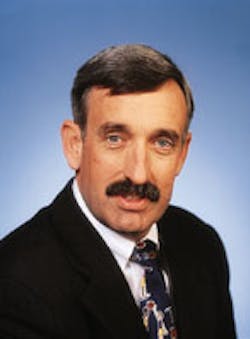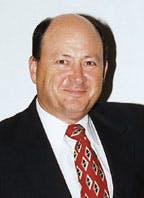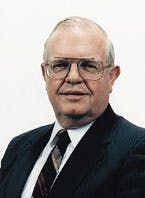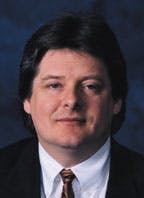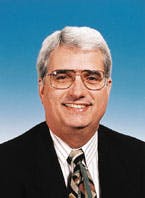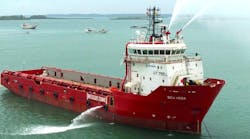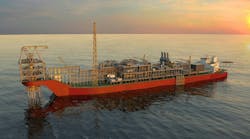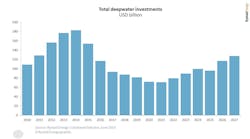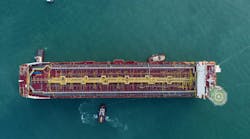The following forecasts by the six members of Offshore Magazine's Editorial Advisory Board provide an annual insight into what challenges production and service companies are focusing maximum attention on in 1997 and the years following.
This year, the board forecasts are focused on how companies and functions will meet the growing demand for more reserves, more rigs, and more equipment, without coming off the quality and efficiency targets achieved in recent years.
There are no easy answers, and a number of glaring problems remain to be solved. Each board member, coming from a different industry sector and professional and corporate orientation, has a different emphasis. Here are their forecasts:
STRATEGIC DRILLING: BEYOND WELL CONSTRUCTION
Thomas R. Bates Jr.
President, Anadrill
Thomas R. Bates, Jr. is president of Anadrill, responsible for Schlumberger's real-time drilling services business: directional drilling, measurements while drilling and logging while drilling. He has held other management positions in Schlumberger companies, including Sedco Forex. Before joining Schlumberger, he worked for six years in drilling research and drilling operations. He is active in SPE, the IADC, the American Association of Drilling Engineers, and the International MWD Society.
For most of this century, drilling has been perceived as a necessary evil - an expensive means of creating a pipeline to flow hydrocarbons to the surface. We are now experiencing a renaissance of drilling technology as a strategic contributor to the profitable development of new oil and gas fields.
This resurgence of drilling technology and drilling engineering was triggered by the dramatic drop in oil prices in the mid-1980s. At the time, drilling budgets accounted for up to 70% of total field development costs. A massive improvement in drilling efficiency was necessary to make many fields, particularly offshore, economically viable.
Horizontal drilling
For many small satellite reservoirs in the North Sea, horizontal and extended-reach drilling are the solutions that boosted well productivity and reduced cost per barrel to profitable levels. As its application grew worldwide, horizontal drilling became a standard completion methodology considered for all reservoirs. At-the-bit sensors now keep horizontal wells in the pay longer and extended-reach wells can strike targets more than five miles (8 km) from the wellhead. With geosteering technology and more powerful drilling motors, operators can exploit rim oil and satellite fields from existing surface infrastructures and nearshore fields can be developed from land locations to reduce costs and minimize environmental impact.
The drilling industry's track record of improving productivity over the last few years has renewed operators' confidence in the power of technology. Over the same period, crude oil supply and demand have reached a balance, prices have increased and today's economics allow us to go after every last drop of oil. Economically increasing total recovery is the strategic drilling challenge of the future. Thus, we are now seeing even more opportunities to apply innovative, new drilling technologies successfully.
Reentry, multilateral drilling
With production declining in many established fields, reentry drilling has surpassed horizontal drilling as the strategic technological answer. Coupled with advanced three-dimensional (3D) seismic interpretations to identify bypassed targets, reentry drilling provides a low-cost methodology to greatly increase total recovery by using the existing platform infrastructure.
In 1996, operators in the US will drill 40% more reentry wells than new horizontals, and this technology is finding application worldwide. Key to reentry work, short-radius drilling motors are especially useful where problem shales overlie the reservoir and coiled tubing drilling is finding application in underbalanced reservoirs. Likewise, multilateral drilling is emerging as a viable option for increasing recovery in many onshore reservoirs and will gradually increase in the offshore environment.
The recent integration of directional drilling with reservoir geophysics to optimize well placement promises to significantly impact recovery. Using a high-quality seismic section and the latest at-the-bit geosteering sensors, drillers can land the bit within a target the size of an engineer's office at a depth and lateral offset of a few miles. With sonic-while-drilling measurements, the bit can be placed on an updated seismic map in real time, allowing drillers to look ahead to anticipate pore pressure changes and select casing points. Drill bit seismic already has the potential to allow drillers to see hundreds of feet ahead of the bit.
In the near future, drilling engineers will go beyond traditional well construction to make strategic drilling a driving force in improving asset value. The economic potential of reservoirs will be fully exploited when real-time drilling data are tightly integrated with existing seismic, geological, petrophysical and production data. Look-ahead and look-around formation measurements from the drillstring will be critical links to a net present value model of the reservoir that will be constantly refined during drilling. Armed with this dynamic reservoir model, drillers will not only operate in geometric and geologic space, but will successfully navigate in economic space as well.
THREE CHALLENGES IN DEEPWATER
W. David Harris
Manager, Offshore Drilling
BP Exploration
David Harris is the manager of offshore drilling, exploration and appraisal for BP Exploration, a position he has held since 1987. Before joining Sohio (now BP Exploration) in 1983 as division drilling engineer for the gulf coast region, he worked in production and drilling assignments in both Gulf Oil Company and Conoco. He is a native of Corsicana, Texas and earned a BS degree in petroleum engineering from Texas A&M University.
With a demonstrated production potential for deepwater accumulations in the Gulf of Mexico and other basins, we now face three primary challenges as we move into even deeper water depths.
First, we must develop cost-effective technologies that allow us to drill and develop fields in ultra-deep waters up to 10,000 ft. Two drillships soon will be capable of drilling in 7,500 ft water depths, with another upgrade to follow in 1998. Additionally, two new drillships have been ordered and will be capable of drilling in 10,000 ft depths. There also is the potential to modify fourth generation semisubmersibles for work in 10,000 ft water depths.
The size and scope of these existing units are driven by the interrelationship of their deckloads, positioning systems, riser loads, and mud volumes. These existing rig concepts could be expanded for work in ultra-deepwater, but current economics will not support the cost of their upgrades.
To build a larger version of the current fourth generation semisubmersible will cost more than $300 million. This type of unit probably will command a day rate of more than $200,000 over a five-year term. Few companies could justify contracting the rig at this rate and very few contractors could afford to build it.
Cost effective ultra-deepwater will come with the development of new technologies and systems of managing risk to eliminate non-productive time and improve efficiency.
Skilled work force
Next, we need a skilled work force capable of handling the increasingly complex and technical tasks dictated by emerging deepwater drilling technologies. With a greater use of human/machine interfaces and sophisticated mooring, positioning, and control systems, ours is rapidly evolving from an industry with a large number of semi-skilled jobs to one which demands highly skilled technicians. Our ongoing challenge will be to effectively train and develop these skills as we grow and renew all of our human resources.
Alliances
Finally, none of us can meet these deepwater challenges alone. By fostering a spirit of greater cooperation among operators and contractors, together, we can develop new possibilities for ultra-deepwater drilling technology, identify opportunities for shared development, and take the necessary steps to deliver cost-effective alternatives.
We must find areas where it is mutually beneficial to exploit technologies and systems now encumbered by the need to develop short-lived competitive advantages. These might include new blowout prevention systems, superior riser designs, or innovative station-keeping or mooring technologies. Through these collaborations, we will establish the standards necessary for safe and efficient operations in deeper waters.
The demand for aggressive deepwater drilling activity is increasing. With project economics setting the pace, it is critical that we develop new options now.
WELLSITE, INFORMATION HANDLING CHALLENGES
Ken R. LeSuer
President, CEO
Halliburton Energy Group
Ken R. LeSuer is president and CEO of Halliburton Energy Group. He joined Halliburton in 1959 as an engineer-in-training upon graduation from Texas A&M University with a BS degree in petroleum engineering. He has held various engineering and management positions throughout Asia and Europe before returning to the US in 1982. He became president and CEO of Halliburton Energy Services in 1994 and assumed his present role in October.
Our industry has made extraordinary gains in efficiency in the last 10 years. Many of the projects we are participating in today were too marginally economical to pursue just a few years ago. The drive for efficiency seems to have been forced upon us by volatile oil and gas prices. Nevertheless, the application of advanced technology and innovative business relationships have helped us progress up the opportunity curve.
Now, we should ask ourselves what we must change to make those projects economical that are not economical today. While exploration costs in real terms have decreased in the last decade, the cost to develop and produce oil and gas has increased. We must take a realistic look at how development projects can be done more efficiently.
Downhole management
New multilateral and intelligent completion technologies will be essential - particularly as they enable real-time production management. The ability to access and re-enter laterals, separate and re-inject downhole, and remotely control downhole systems is valuable only to the extent that we manage the reservoir more efficiently. These technologies will enable us to do so.
We will also need to gain better efficiency from the mounds of data we collect. Consider the amount of time that is spent looking for data and trying to integrate information between applications. There is a leap in productivity available when we are able to rapidly move large amounts of data from the field, whether from seismic data collection or production facilities, directly into the office and back again. The ability to make decisions in real time will dramatically shorten cycle times and increase productivity across the entire oilfield life cycle.
Alignment of interests
The other vehicle for progress is in better alignment of our business interests. To do so, projects must become more incentive-based, with the reward contingent on achieving the desired results. Service companies should be willing to base compensation on economic value factors - like total system cost, health, safety, and environmental exposure, and production needs - rather than the number of people and amount of equipment on location. The goals of the oil company and service company are better aligned and achieved when the rewards and risks are shared.
We know from experience that an industry subject to the vagaries of political, social, and economic realities can be certain only of uncertainty. If we continue to change the right things, however, we will made progress on the opportunity curve.
AFFORDABLE 3D OPENING UP DEEPWATER
Bjarte Bruheim
President
Petroleum Geo-Services
Bjarte Bruheim is the president and chief operating officer of Petroleum Geo-Services ASA. He has more than 15 years experience in the use of 3D marine seismic technology. Previously, he was president of PGS Exploration (US) and was also employed by Geco Geophysical Company (Schlumberger). He graduated from the Norwegian Institute of Technology, Trondheim University with a master's degree in physics.
During the last decade, the offshore industry has struggled through a downturn with significant cutbacks of staff and research and development budgets. However, during the same period, the oilfield service industry has developed some of the most value-added technology that will shift a major part of offshore activities from the mature areas on the shelf to the deepwater areas worldwide. Some of the technology that will make a major impact are as follows:
- 3D seismic acquisition, including onboard processing
- Massive parallel computers for depth imaging in subsalt exploration
- Horizontal and multi-lateral drilling
- Subsea completion technology
- 4D seismic for reservoir monitoring of producing fields
- Floating production systems.
We have seen the impact of these technologies over the past few years as the exploration and production industry has reduced cost and risk significantly. We have also seen the same technology used to develop major fields in 3-4 years, compared with 7-8 years just a decade ago. This acceleration increases the value of future production.
The industry has documented the success of 3D prior to drilling in the more mature basins worldwide. The new trend in the industry is to acquire 3D seismic before drilling in frontier areas, as well, where geology is less known.
Major discoveries in the Gulf of Mexico and West Africa deepwater are fueling the demand for this "exploration 3D." The major reason why exploration 3D will replace the more traditional 2D seismic relates to the drastic reduction in the cost of acquiring and processing the 3D survey.
The cost of proprietary 3D data has been reduced from $24,000 per sq. km in 1990 to $6,000-8,000 per sq. km in 1996. Even better, if an oil company buys a license to the data from the contractor instead of owning the data, the same data can be purchased for less than $2,000 per sq. km. In the industry, this product is known as a multi-client or a non-exclusive survey.
The technology that encouraged this development was the introduction of large purpose-built seismic vessels, such as the Ramform, deployed in 1995 and 1996 utilizing up to 16 parallel streamers and scaleable massive onboard parallel computers for quick delivery of the 3D volume.
As an example, this season in a region West of Shetland, 800 sq. km of 3D data was acquired in one month and the oil companies had a 3D volume loaded on their interpretation workstation 40 days after the acquisition was complete.
This substantially reduced delivery time and cost opens up opportunities to utilize high quality, inexpensive exploration 3D data that most likely will increase success of offshore deepwater drilling in the near future.
WIDER APPLICATIONS FOR FUTURE FPSO UNITS
George F. Remery
Senior Vice President
Single Buoy Moorings
George F. Remery is senior vice president of Single Buoy Moorings in Monaco and responsible for all research, development, and engineering activities of the company. He has been with SBM for 18 years. Prior to that , he worked with the Marin Institute in Wageningen. He is a member of the Deep Offshore Technology advisory committee and the supervisory boards of Marin, Gusto, and Imodco. He holds an MS in naval architecture from the University of Delft.
As 1996 draws to a close, everyone wants to know: Will the offshore oil and gas industry experience yet another year of developing more small and medium size fields, in even deeper water, which contain hydrocarbons that are yet more difficult to recover and treat?
The answer is almost certainly positive. Driven by the international oil companies' increasing exploration and production budgets, and the availability of the technological competence by a number of contractors, the year 1977 will almost certainly bring new records from new field developments.
The increasing demand for oil and gas, and the higher profits made by the oil companies, resulting from their in-house restructuring and the present increase in the oil price, are the main reasons behind the expected increase in oil companies' exploration and production budgets.
Technical competence
Technological competence available from a number of contractors provides the means required to extrapolate existing technical solutions into the development tools that are required for deeper waters, harsher environments, and more complicated reservoirs and field layouts.
Such technological competence is really only available from contractors who have developed the knowledge and skills from extensive research and development efforts over many years, and from the experience gained from several real applications of increasing complexity.
New contracting strategies, such as alliancing and partnering, are bringing the required core competence together in a single party, thus increasing the chances for proper optimization of the production system with respect to quality, safety, capital expenditure, and operating costs.
However, these new contracting strategies will only be successful is also new project management structures are put in place with clear and strong leadership equipped with the proper mechanisms for making decisions.
Since the technology with FPSO systems, which has been available for a number of years, is now accepted by the industry as being reliable and sufficiently mature, the use of FPSO systems for general field development has recently increased significantly. This trend can be expected to continue, since FPSO systems are now selected for many different reasons:
- Their relocatability and associated suitability for use in more than one field makes them suitable for the smaller fields, even in the shallow waters of areas which have a fully developed infrastructure, such as the North Sea.
- Because they are robust floaters with a large waterline area, they are not very water-depth dependent and can be used for fields in very deep water, such as offshore Italy and Brazil.
- Because their size and shape can be selected to give them proper seakeeping characteristics, they can be used in harsh environments (west of Shetlands, Terra Nova).
- Since they are self-contained units, they are traditionally conceived for remote areas.
We, therefore, expect to experience a very busy and extremely interesting year for FPSO development in 1977. It will bring the application of FPSO systems in record-breaking water depths to even beyond the 1,000-meter level by possible using synthetic materials in the anchor legs, while first operational experience will be obtained from vessels installed in the harsh environments of the Atlantic offshore, Shetlands, and the Northern North Sea.
CHANGING ROLE OF R&D
David M. Clementz
President
Chevron Petroleum Technology
David M. Clementz is the president of Chevron Petroleum Technology, a wholly owned subsidiary of Chevron responsible for research, technology development, and support of technical services in exploration and production. He holds a doctorate in soil science from Michigan State University and an MBA from Pepperdine University. He joined the company in 1973 as a research chemist and has held several positions in production engineering.
Ours is a capital-intensive and technology-intensive commodities business. The way to stay competitive is through making smart capital investments (that is, picking the right projects) and through technology substitution to lower costs and increase opportunities for new investments. Technology substitution has allowed us to continue to operate in more complex environments at reasonable costs.
For example, many companies are betting on technology substitution to enable them to economically produce their new deepwater leases. It is pretty clear to me, then, that the management of the process which leads us to better enable technology substitution is critical to our future. That process is innovation. Innovation, defined by Webster, is "the introduction of something new."
The management of innovation is a key business process. Whether recognized, written down, flow-charted or not, what technical managers do in their daily work is manage innovation. Research and development (R&D) are vital components of the innovation process and their role is changing.
Some segments of our industry are moving away from the linear model of innovation. In that model, technology passes from R&D to production to the market in a linear fashion. Technology transfer is time-linear and science and technologies tend to be the drivers.
Managing innovation
In Chevron, we are moving toward a total process view of innovation where the central process is design, rather than science or technology. The forces driving innovation are the economic forces of the marketplace rather than scientific initiatives. Science is the combination of stored knowledge and the process of R&D that interacts with the innovation process throughout the cycle. Research is as a process (small "r") in this model rather than an organization. It becomes an enabling part of the innovation process from start to finish. Our philosophy is consistent with a national trend documented in "Engines of Innovation" by Rosenbloom and Spencer (1966 - Harvard Press)
I believe we are at the beginning of a new era of industry R&D. While internal invention will remain critical in selected areas, R&D groups will emphasize timely delivery and external collaboration as a means to enable continuous innovation. Processes that link them to the market needs will clarify their role in the business partnership. This clarity will speed technology substitution and provide new opportunities to maintain competitiveness as complexity increases.
Copyright 1996 Offshore. All Rights Reserved.
